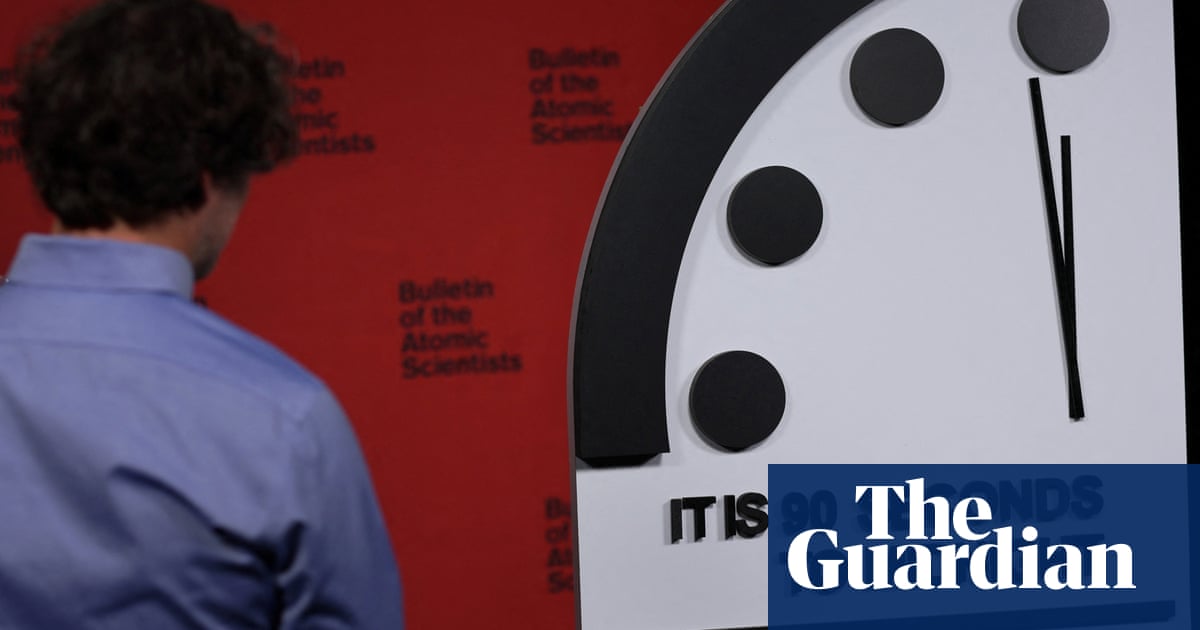Wars and climate crisis keep Doomsday Clock at 90 seconds to midnight | World news


The Doomsday Clock, a symbolic countdown to human extinction, has stayed at 90 seconds to midnight, the closest it had been since it was established in 1947, a panel of international scientists has said.
The Bulletin of the Atomic Scientists cited the continuing threat of a nuclear escalation in Ukraine, the “horrors of modern war” in Israel and Gaza and the lack of action on the climate crisis, which threatens “billions of lives”.
“Ninety seconds to midnight is profoundly unsustainable,” said Rachel Bronson, the president and chief executive of the organisation.
Last year, the Bulletin set its metaphorical Doomsday Clock at 90 seconds to midnight, the closest it had been since it was established after the second world war.
The panel of international scientists said in 2023 that humanity’s continued existence was at greater risk than ever before, largely as a result of the invasion of Ukraine and Russia’s “thinly veiled threats to use nuclear weapons”.
Founded in 1945 by Albert Einstein and others who helped develop the first atomic weapons, the Bulletin attempts to educate people on potentially world-ending dangers.
Every year, the Bulletin updates the time of its symbolic Doomsday Clock to illustrate global human-created threats it considers existential, including nuclear war and biothreats – such as Covid-19 – artificial intelligence and the climate crisis. Striking midnight represents the end of the world.
The hands of the clock are set each year by the Bulletin’s science and security board with the support of its board of sponsors, which includes 10 Nobel laureates.
In its 2024 announcement, the Bulletin said a variety of global threats influenced their decision including: “the Russia-Ukraine war and deterioration of nuclear arms reduction agreements; the climate crisis and 2023’s official designation as the hottest year on record; the increased sophistication of genetic engineering technologies; and the dramatic advance of generative AI, which could magnify disinformation and corrupt the global information environment making it harder to solve the larger existential challenges”.
The Bulletin has been criticised for using “scare tactics” with the clock gradually but alarmingly moving closer and closer to midnight over the decades.
Before 2017, when it moved to two minutes and 30 seconds to midnight, the clock had only used whole minutes. Since 2020, it has started to use seconds, moving to 100 seconds to midnight.
In response to criticism, the Bulletin says it has no political agenda and that the clock hand has been moved away from midnight almost as often as it has moved it towards it.
In the latest announcement, Bronson said there was still cause for hope, despite the 90-second position. “It’s urgent for governments and communities around the world to act. And the Bulletin remains hopeful, and inspired, in seeing the younger generations leading the charge.”
The closest the clock came to midnight at the height of the cold war was 11:58pm in 1953 after the first detonation of a thermonuclear warhead, a hydrogen bomb. In the early 1990s, after the optimism at the end of the cold war, the clock moved its furthest away from danger and was set at 17 minutes from midnight.
It has been moving closer towards extinction ever since.
Source link




